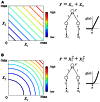Adaptive stimulus optimization for sensory systems neuroscience
- PMID: 23761737
- PMCID: PMC3674314
- DOI: 10.3389/fncir.2013.00101
Adaptive stimulus optimization for sensory systems neuroscience
Abstract
In this paper, we review several lines of recent work aimed at developing practical methods for adaptive on-line stimulus generation for sensory neurophysiology. We consider various experimental paradigms where on-line stimulus optimization is utilized, including the classical optimal stimulus paradigm where the goal of experiments is to identify a stimulus which maximizes neural responses, the iso-response paradigm which finds sets of stimuli giving rise to constant responses, and the system identification paradigm where the experimental goal is to estimate and possibly compare sensory processing models. We discuss various theoretical and practical aspects of adaptive firing rate optimization, including optimization with stimulus space constraints, firing rate adaptation, and possible network constraints on the optimal stimulus. We consider the problem of system identification, and show how accurate estimation of non-linear models can be highly dependent on the stimulus set used to probe the network. We suggest that optimizing stimuli for accurate model estimation may make it possible to successfully identify non-linear models which are otherwise intractable, and summarize several recent studies of this type. Finally, we present a two-stage stimulus design procedure which combines the dual goals of model estimation and model comparison and may be especially useful for system identification experiments where the appropriate model is unknown beforehand. We propose that fast, on-line stimulus optimization enabled by increasing computer power can make it practical to move sensory neuroscience away from a descriptive paradigm and toward a new paradigm of real-time model estimation and comparison.
Keywords: adaptive data collection; neural network; optimal stimulus; parameter estimation; sensory coding.
Figures







Similar articles
-
Fitting of dynamic recurrent neural network models to sensory stimulus-response data.J Biol Phys. 2018 Sep;44(3):449-469. doi: 10.1007/s10867-018-9501-z. Epub 2018 Jun 2. J Biol Phys. 2018. PMID: 29860641 Free PMC article.
-
Adaptive Stimulus Design for Dynamic Recurrent Neural Network Models.Front Neural Circuits. 2019 Jan 22;12:119. doi: 10.3389/fncir.2018.00119. eCollection 2018. Front Neural Circuits. 2019. PMID: 30723397 Free PMC article.
-
Adaptive coding for dynamic sensory inference.Elife. 2018 Jul 10;7:e32055. doi: 10.7554/eLife.32055. Elife. 2018. PMID: 29988020 Free PMC article.
-
Complete functional characterization of sensory neurons by system identification.Annu Rev Neurosci. 2006;29:477-505. doi: 10.1146/annurev.neuro.29.051605.113024. Annu Rev Neurosci. 2006. PMID: 16776594 Review.
-
From response to stimulus: adaptive sampling in sensory physiology.Curr Opin Neurobiol. 2007 Aug;17(4):430-6. doi: 10.1016/j.conb.2007.07.009. Epub 2007 Aug 8. Curr Opin Neurobiol. 2007. PMID: 17689952 Review.
Cited by
-
Optimizing optogenetic stimulation protocols in auditory corticofugal neurons based on closed-loop spike feedback.J Neural Eng. 2019 Oct 29;16(6):066023. doi: 10.1088/1741-2552/ab39cf. J Neural Eng. 2019. PMID: 31394519 Free PMC article.
-
Estimating the Parameters of Fitzhugh-Nagumo Neurons from Neural Spiking Data.Brain Sci. 2019 Dec 9;9(12):364. doi: 10.3390/brainsci9120364. Brain Sci. 2019. PMID: 31835351 Free PMC article.
-
On the synthesis of visual illusions using deep generative models.J Vis. 2022 Jul 11;22(8):2. doi: 10.1167/jov.22.8.2. J Vis. 2022. PMID: 35833884 Free PMC article.
-
Fitting of dynamic recurrent neural network models to sensory stimulus-response data.J Biol Phys. 2018 Sep;44(3):449-469. doi: 10.1007/s10867-018-9501-z. Epub 2018 Jun 2. J Biol Phys. 2018. PMID: 29860641 Free PMC article.
-
Temporal Code-Driven Stimulation: Definition and Application to Electric Fish Signaling.Front Neuroinform. 2016 Oct 6;10:41. doi: 10.3389/fninf.2016.00041. eCollection 2016. Front Neuroinform. 2016. PMID: 27766078 Free PMC article.
References
-
- Ahrens M. B., Paninski L., Sahani M. (2008b). Inferring input nonlinearities in neural encoding models. Network 19 35–67 - PubMed
-
- Albrecht D. G., DeValois R. L., Thorell L. G. (1980). Visual cortical neurons: are bars or gratings the optimal stimuli? Science 207 88–90 - PubMed
-
- Albrecht D. G., Hamilton D. B. (1982). Striate cortex of monkey and cat: contrast response function. J Neurophysiol. 48 217–237 - PubMed
Publication types
MeSH terms
Grants and funding
LinkOut - more resources
Full Text Sources
Other Literature Sources

